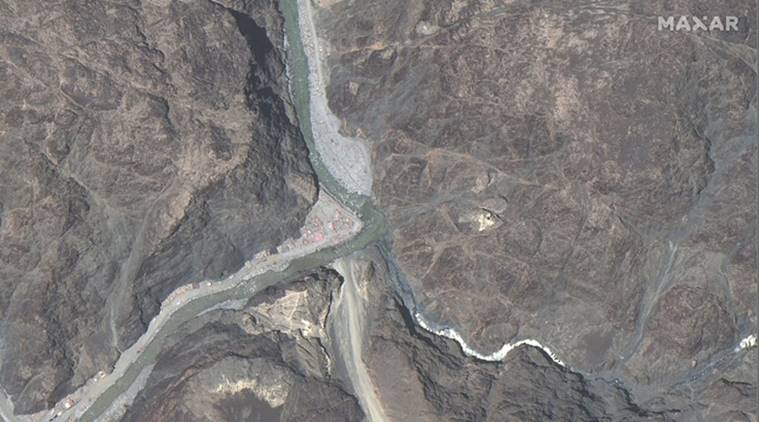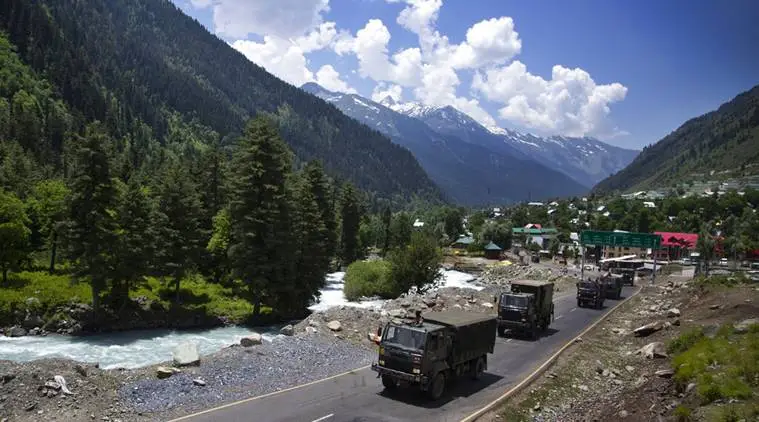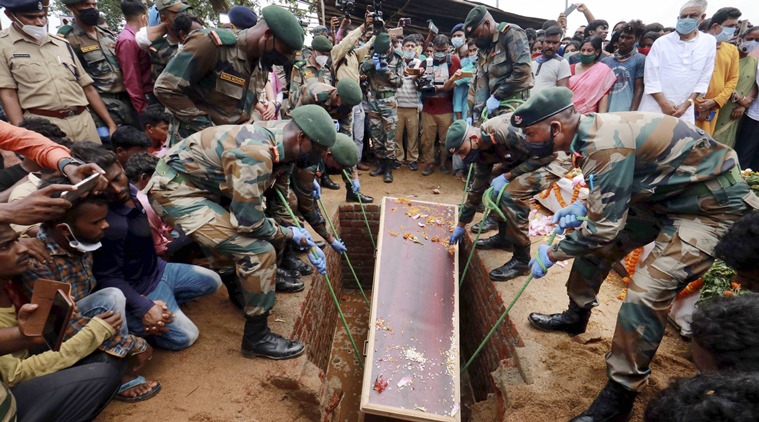 Maxar WorldView-3 satellite image shows area near the Line of Actual Control (LAC) and Patrolling Point 14 in the eastern Ladakh sector June 22, 2020. (Maxar Technologies via Reuters)
Maxar WorldView-3 satellite image shows area near the Line of Actual Control (LAC) and Patrolling Point 14 in the eastern Ladakh sector June 22, 2020. (Maxar Technologies via Reuters)
India-China Border Latest News Live Update: New satellite images have revealed Chinese structures back at Galwan Valley, the site of the June 15 clashes that left 20 Indian soldiers dead. Top sources in the Army told The Indian Express “the tent which was removed on June 15 has been reported back by our ground troops at PP-14 (Patrolling Point 14)”. The structures have been built between June 16 and June 22 because Planet Labs satellite images of the location on June 16, a day after the clashes, do not show any such infrastructure.
In other news, Indian and Chinese diplomats agreed Wednesday to “sincerely implement the understanding on disengagement and de-escalation” along the Line of Actual Control (LAC) in Ladakh. At the two-and-half hour meeting of the Working Mechanism for Consultation & Coordination on India-China Border Affairs (WMCC), diplomats agreed to maintain communication both at diplomatic and military levels to “resolve the existing situation peacefully”, the Ministry of External Affairs said.
Meanwhile, in what is seen as another intrusion, the Chinese army has crossed the border at the Depsang plains to the north. The PLA has moved up to a place called Y-junction or Bottleneck on the Depsang plains, which is around 18 km on the Indian side of the LAC.
The Chinese have previously entered Indian territory at Depsang, senior Congress leader and former defence minister A K Antony told The Indian Express. “A serious incursion took place during the UPA period in Depsang in 2013… It took 21 days in 2013… they had come in large numbers… put tents and everything… there was face to face scuffle… but after 21 days… after military and diplomatic-level discussions they went back. Status quo ante was restored,” he said in an interview.
 India-China border news live updates: An Indian Army convoy moves on the Srinagar-Ladakh highway at Gagangeer, northeast of Srinagar. (AP Photo)
India-China border news live updates: An Indian Army convoy moves on the Srinagar-Ladakh highway at Gagangeer, northeast of Srinagar. (AP Photo) Army personnel bury the mortal remains of Rajesh Orang during his funeral ceremony, at Belgoria village in Birbhum district of West Bengal, Friday, June 19, 2020. (PTI Photo)
Army personnel bury the mortal remains of Rajesh Orang during his funeral ceremony, at Belgoria village in Birbhum district of West Bengal, Friday, June 19, 2020. (PTI Photo)
Notwithstanding this structural political tension and the essential complexity of military disengagement, the fact that talks are taking place is a good sign. Equally welcome is the fact that the Indian and Chinese troops marched in Moscow at an international military event to mark the 75th anniversary of Russian victory in the Second World War. The Indian and Chinese foreign ministers also joined the Russian foreign minister in a prescheduled video conference. On balance, then, it is too early to celebrate the presumed agreement on military disengagement in the Ladakh frontier. India must remain vigilant, it’s a long road ahead. Read The Indian Express' editorial
Senior Congress leader and former defence minister A K Antony speaks to Manoj C G about the situation in Ladakh and his assessment of the way forward. "The whole country was under the euphoria of the Mahabalipuram discussions with the Chinese President. Galwan Valley was never a point of dispute. It is a betrayal by China. It is for the government to see to it that our sovereignty is protected," he says. Read the entire interview here
Indian and Chinese diplomats agreed Wednesday to “sincerely implement the understanding on disengagement and de-escalation” along the Line of Actual Control in Ladakh. At the meeting of the Working Mechanism for Consultation & Coordination on India-China Border Affairs (WMCC), the Indian side “conveyed its concerns” on the developments in eastern Ladakh, including the June 15 showdown in Galwan Valley in which 20 Indian Army personnel were killed.
The Ministry of External Affairs said it was emphasised that both sides should “strictly respect and observe” the Line of Actual Control.
The Chinese statement mentioned the exchange of “candid and in-depth” views on the border situation and how both sides said they will “earnestly implement the important consensus” reached by the Foreign Ministers during their June 17 phone conversation, and “actively accommodate with the two military forces to implement the outcome reached” at the June 6 and June 22 military talks.
As India and China hold diplomatic and military talks to disengage troops along the Line of Actual Control in eastern Ladakh, new satellite images show that the Chinese have built a defensive position at the Galwan Valley site of the June 15 clashes in which 20 Indian Army personnel were killed.
Senior sources in the Army confirmed that “the tent which was removed on June 15 has been reported back by our ground troops at PP-14 (Patrolling Point 14)”. Reached for comment, the Army did not confirm or deny the existence of Chinese structures visible in the
As India and China grapple with rising tensions in the Galwan Valley, Hot Springs and Pangong Tso on the Line of Actual Control (LAC), the Chinese army has crossed the border in another strategic area to the north, the Depsang plains. This intrusion is seen as another attempt by the Chinese to shift the LAC further west on the disputed boundary.
Around 30 km south-east from the important airstrip of Daulat Beg Oldie (DBO), the Chinese army has moved and deployed in large numbers up to a place called Y-junction or Bottleneck on the Depsang plains. Sources said the Chinese deployments include troops, heavy vehicles, specialist military equipment. READ HERE
For more satellite images, click here
Claim on Galwan valley: As Beijing staked claim over Galwan Valley, India said it is not in accordance with China’s own position in the past. Beijing never claimed the valley since 1962.
China: Galwan Valley is located on Chinese side of LAC in west section of China-India boundary. For many years, Chinese border troops have been patrolling in this region. Since April this year, Indian border troops have unilaterally and continuously built roads, bridges and other facilities at the LAC in Galwan Valley.
India: The position with regard to Galwan Valley area has been historically clear. Attempts by the Chinese to now advance exaggerated and untenable claims on LAC there are not acceptable. They are not in accordance with China’s own position in the past.
Patrolling: Beijing accuses India of building infrastructure, but India says all infrastructure built is on its own side of LAC.
China: Since April this year, Indian border troops have unilaterally and continuously built roads, bridges and other facilities at the LAC in Galwan Valley. China has lodged representations and protests on multiple occasions but India has gone even further to cross the LAC and made provocations.
India: Indian troops are familiar with the alignment of LAC in all sectors of border areas, including in Galwan Valley. They abide by it scrupulously, as they do elsewhere. The Indian side has never undertaken any actions across the LAC. In fact, they have been patrolling this area for a long time without any incident. All infrastructure built by the Indian side is naturally on its own side. Read more here
The Chinese statement mentioned the exchange of “candid and in-depth” views on the border situation and how both sides should earnestly implement the “important consensus” reached between the Foreign Ministers during their June 17 phone conversation, and “actively cooperate” with the armed forces to implement outcomes reached at the June 6 and June 22 military talks.
The Chinese Defence Ministry, however, struck a jarring note, echoing Beijing’s claim to the Galwan Valley. “China has sovereignty over the Galwan Valley region and the Chinese border troops have been patrolling and on duty in this region for many years,” it said. This is the first time that the Chinese armed forces have staked claim to an area that India says is well within its territory. Read more here
India and China emphasised that both sides should strictly respect and observe the Line of Actual Control (LAC) and reaffirmed that they should sincerely implement the understanding on disengagement and de-escalation that was reached by the senior commanders on June 6, the Ministry of External Affairs (MEA) said in a statement following the Working Mechanism for Consultation and Coordination (WMCC) meeting on India-China Border Affairs.
'The two delegations agreed that implementation of this understanding expeditiously, in accordance with the bilateral agreements and protocols would help ensure peace and tranquillity in border areas and the development of broader relationship between the two countries. In this context, they also took note of the discussions in the second meeting of the Senior Commanders held on 22 June,' the MEA said.
The two sides, the MEA said, also agreed to maintain communication both at diplomatic and military level including under the framework of WMCC to resolve the existing situation peacefully.
Lt General AL Chavan, who was the Commander of the 3rd Infantry Division in Ladakh in 2013, when Chinese troops had come into Depsang Valley leading to a standoff, writes that of the nearly 50-km long Galwan Nala, 45 km lie to the Southeast of India’s perception of the Line of Actual Control (LAC) at Patrol Post 14, which is five to six km east of where Galwan Nala meets Shyok river. This is why China claims that Galwan Valley belongs to them.
In Pangong Tso, both sides used to patrol till their claim lines, which is Finger 8 for India and Finger 4 for China. Prime Minister Narendra Modi was technically correct when he said there is no intrusion in our “borders” the Chinese have deployed at Finger 5, and our troops are deployed at Finger 4, the endeavour is for the Chinese go East of the Finger 8 and we move back West to our original position, thus restoring status quo ante as obtaining on 20 April 2020. Read more here
Army Chief General MM Naravane inspects forward areas in Eastern Ladakh and reviews operational situation on ground
Here are a couple of pictures of Chinese troops participating in the Victory Day military parade in Moscow, Russia. (AP Photos)
A Tri-Service contingent of the Indian Armed Forces participates in the Victory Day military parade in Moscow, Russia:
Don't miss our explainer on Victory Day: Victory Day marks the end of World War II and the victory of the Allied Forces in 1945. Adolf Hitler had shot himself on April 30. On May 7, German troops surrendered, which was formally accepted the next day, and came into effect on May 9, explains Krishn Kaushik. Read more here
Defence Minister Rajnath Singh tweets, "Attending the Victory Day Parade at Red Square in Moscow today to commemorate the 75th Anniversary of Victory of the Soviet People in the great Patriotic War of 1941-1945. I am proud that a Tri-Service contingent of the Indian Armed Forces is also participating in this parade," he says.
The Victory Day military parade is underway in Moscow, Russia. Defence Minister Rajnath Singh is in the Russian capital to attend the 75th anniversary of the Victory Day celebration to mark the end of Second World War. His Chinese counterpart General Wei Fenghe is also attending the event. Indian and Chinese troops are participating in the parade, along with contingents from other countries.
The parade was to be held on May 9 but was postponed to June 24 due to Covid-19.
BJP president J P Nadda took to Twitter earlier this morning, saying the nation was "united and supportive" of the armed forces, and the "relaunch of the scion for the nth time can wait".
Real time intelligence, surveillance equipment must be available to field formations. We need to strategise for the future, including the modern manifestations of non-contact, non-kinetic warfare, writes Rakesh Sharma in an opinion column in The Indian Express.
With his Chinese counterpart watching via a video link, External Affairs Minister S Jaishankar said the “leading voices of the world must be exemplars in every way” and that the “challenge today is not just one of concepts and norms, but equally of their practice”. Jaishankar was speaking at the Russia-India-China (RIC) foreign ministers’ virtual meeting. Read more here
Also watch: Air surveillance in Leh
Bilateral relations between India and China cannot progress unless there is peace on the borders and China recognises that India too has non-negotiable core concerns, aspirations and interests. The principle of equal and mutual security is fundamental. No country can have a veto on India’s relations with any other country or group of countries, writes Nalin Surie, a former ambassador to China and is currently Distinguished Fellow at the Delhi Policy Group.